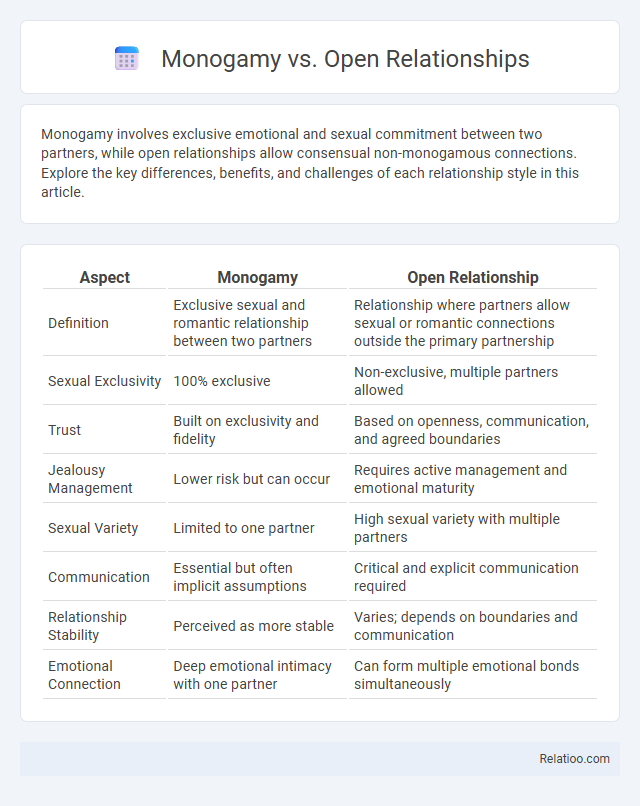Monogamy involves exclusive emotional and sexual commitment between two partners, while open relationships allow consensual non-monogamous connections. Explore the key differences, benefits, and challenges of each relationship style in this article.
Table of Comparison
| Aspect | Monogamy | Open Relationship |
|---|---|---|
| Definition | Exclusive sexual and romantic relationship between two partners | Relationship where partners allow sexual or romantic connections outside the primary partnership |
| Sexual Exclusivity | 100% exclusive | Non-exclusive, multiple partners allowed |
| Trust | Built on exclusivity and fidelity | Based on openness, communication, and agreed boundaries |
| Jealousy Management | Lower risk but can occur | Requires active management and emotional maturity |
| Sexual Variety | Limited to one partner | High sexual variety with multiple partners |
| Communication | Essential but often implicit assumptions | Critical and explicit communication required |
| Relationship Stability | Perceived as more stable | Varies; depends on boundaries and communication |
| Emotional Connection | Deep emotional intimacy with one partner | Can form multiple emotional bonds simultaneously |
Understanding Monogamy: Definition and Core Principles
Monogamy is a committed romantic relationship structure where two individuals agree to exclusivity, emphasizing emotional and sexual fidelity. Core principles of monogamy include trust, loyalty, and mutual respect, fostering a stable and secure bond. Understanding your personal values about monogamy helps navigate relationship expectations and build lasting intimacy.
What is an Open Relationship? Key Aspects and Variations
An open relationship is a consensual arrangement where partners agree to engage in romantic or sexual activities with others outside their primary relationship, emphasizing transparency and mutual consent. Key aspects include clear communication, negotiated boundaries, and trust to manage jealousy and maintain emotional connection. Variations range from casual non-monogamy, where partners have occasional outside encounters, to polyamory, which involves multiple committed relationships simultaneously.
Historical Perspectives: The Evolution of Relationship Structures
Monogamy, rooted in ancient agricultural societies, evolved as a dominant relationship structure promoting social stability and inheritance clarity across civilizations. Open relationships, historically found in various cultures such as indigenous tribes and certain aristocratic circles, reflect a fluid approach to partnership that accommodates personal freedom and communal bonding. The resurgence of open relationships in modern times highlights a shift towards diverse relational models challenging traditional monogamous norms while emphasizing communication and consent.
Psychological Benefits of Monogamy
Monogamy fosters deep emotional security and trust, which are crucial for long-term psychological well-being. Your brain releases oxytocin and dopamine during monogamous bonding, enhancing feelings of attachment and happiness. This stability can reduce anxiety and depression, promoting mental health resilience over time.
Emotional and Psychological Aspects of Open Relationships
Open relationships often foster enhanced emotional communication and self-awareness, as partners navigate boundaries and negotiate needs with heightened transparency. Psychological benefits include increased trust-building and reduced fear of abandonment, though challenges like jealousy and insecurity require strong emotional resilience and mutual support. Understanding these dynamics can lead to more adaptive coping strategies and personal growth compared to traditional monogamous frameworks.
Common Myths About Monogamy and Open Relationships
Common myths about monogamy include the belief that it guarantees lifelong happiness and infidelity avoidance, while open relationships are often misunderstood as inherently unstable or based solely on casual sex. Research shows that both relationship types require communication, trust, and commitment to thrive, debunking the stereotype that monogamy is more "moral" or that open relationships lack emotional depth. Studies indicate that satisfaction in monogamous and open relationships depends on individual compatibility and mutual agreement rather than adherence to traditional relationship structures.
Communication: The Foundation of Successful Relationships
Effective communication is the cornerstone of any successful relationship, whether it's monogamy or an open relationship, ensuring clarity around boundaries, expectations, and emotional needs. In monogamous relationships, open dialogue fosters trust and intimacy by addressing concerns directly, while in open relationships, transparent communication is essential for negotiating terms and maintaining mutual respect. Your ability to express feelings honestly and listen actively strengthens the relationship's foundation, reducing misunderstandings and promoting long-term satisfaction.
Navigating Jealousy and Trust Issues
Navigating jealousy and trust issues in monogamy requires clear communication and consistent emotional reassurance to strengthen your bond. Open relationships demand established boundaries and transparent dialogue to manage feelings of insecurity and maintain mutual trust effectively. Understanding your emotional needs and setting realistic expectations can help foster stability and growth regardless of the relationship model you choose.
Societal Views and Cultural Influences
Societal views on monogamy, open relationships, and polyamory differ significantly due to cultural traditions and religious beliefs that often prioritize monogamous unions as the normative standard. Open relationships and polyamory face varying degrees of acceptance influenced by progressive social movements and shifting attitudes toward personal freedom and relationship diversity. Cultural influences shape the legal recognition, social support, and stigma associated with each relationship style, affecting how individuals navigate their personal identities within their communities.
Choosing What Works: Factors to Consider for Your Relationship
Choosing between monogamy and open relationships depends on trust, communication, and individual needs for intimacy and freedom. Emotional compatibility and mutual agreement on boundaries are critical to maintaining satisfaction and preventing conflicts. Assessing personal values, lifestyle goals, and willingness to navigate challenges ensures the relationship structure supports long-term happiness.

Infographic: Monogamy vs Open Relationship
 relatioo.com
relatioo.com